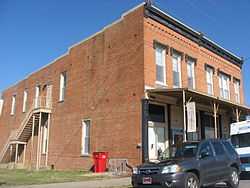Livermore, Kentucky
| Livermore, Kentucky | |
|---|---|
| City | |
|
McLean County Public Library | |
|
Location of Livermore, Kentucky | |
| Coordinates: 37°29′28″N 87°8′7″W / 37.49111°N 87.13528°WCoordinates: 37°29′28″N 87°8′7″W / 37.49111°N 87.13528°W | |
| Country | United States |
| State | Kentucky |
| County | McLean |
| Incorporated | 1850 |
| Area | |
| • Total | 1.0 sq mi (2.7 km2) |
| • Land | 1.0 sq mi (2.7 km2) |
| • Water | 0.0 sq mi (0.0 km2) |
| Elevation | 407 ft (124 m) |
| Population (2000) | |
| • Total | 1,482 |
| • Density | 1,438.1/sq mi (555.3/km2) |
| Time zone | Central (CST) (UTC-6) |
| • Summer (DST) | CDT (UTC-5) |
| ZIP code | 42352 |
| Area code(s) | 270 |
| FIPS code | 21-47062 |
| GNIS feature ID | 0496908 |
Livermore (local /ˈlivərmɔːr/)[1] is a home rule-class city[2] located at the confluence of the Green and Rough rivers in McLean County in the U.S. state of Kentucky. The population was 1,482 at the time of the year 2000 U.S. census. It is included in the Owensboro metropolitan area.
Geography
Livermore is located at 37°29′28″N 87°8′7″W / 37.49111°N 87.13528°W (37.490987, -87.135340).[3] According to the United States Census Bureau, the city has a total area of 1.0 square mile (2.6 km2), all land.
History
Early years
William Brown founed the city in 1837 as Brown's Landing, but the post office established the next year took the name Livermore. The origin is disputed: some historians trace it to an otherwise-unknown shopkeeper named James Livermore, others to civil engineer Alonzo Livermore who helped construct a dam across the Green River at Rumsey.[1] The city was formally incorporated by the state assembly in 1850.[4][5]
Opera house lynching
Livermore achieved national and international notoriety in the second decade of the 20th Century for a bizarre lynching. On April 20, 1911, a black man named Will Porter (or Potter) shot and wounded Frank Mitchell, a white man, after a barroom argument. Sheriff V.P. Stabler then arrested Porter. After this, accounts vary. The New York Times account holds that a local mob of fifty overwhelmed the sheriff, who had hid Porter in the opera house basement to protect him. They then bound Porter's hands and feet, took him to the center stage, and shot him there.[6] Another version reported by several Kentucky papers omitted the sheriff's concern and had Porter taken from the jail to the opera house, where admission was charged to witness the hanging. Those in the gallery were permitted a single shot at Porter; those in the orchestra seats were allowed to empty their guns.[7]
The NAACP quickly condemned the lynching and sent letters to Pres. Taft, the Congress, and Gov. Willson of Kentucky. At Willson's insistence, Kentucky issued warrants for 18 of the lynchers; three leaders – including Mitchell's brother Lawrence – were separately indicted and tried for murder, but quickly acquitted.[7]
Demographics
As of the census[8] of 2000, there were 1,482 people, 614 households, and 405 families residing in the city. The population density was 1,438.1 people per square mile (555.5/km²). There were 667 housing units at an average density of 647.3 per square mile (250.0/km²). The racial makeup of the city was 97.98% White, 0.07% African American, 0.13% Native American, 0.07% Asian, 0.81% from other races, and 0.94% from two or more races. Hispanic or Latino of any race were 1.75% of the population.
There were 614 households out of which 33.7% had children under the age of 18 living with them, 46.7% were married couples living together, 15.0% had a female householder with no husband present, and 33.9% were non-families. 30.3% of all households were made up of individuals and 15.5% had someone living alone who was 65 years of age or older. The average household size was 2.41 and the average family size was 3.01.
In the city the population was spread out with 27.1% under the age of 18, 9.7% from 18 to 24, 25.0% from 25 to 44, 23.7% from 45 to 64, and 14.6% who were 65 years of age or older. The median age was 37 years. For every 100 females there were 88.3 males. For every 100 females age 18 and over, there were 82.0 males.
The median income for a household in the city was $23,086, and the median income for a family was $27,404. Males had a median income of $25,083 versus $19,583 for females. The per capita income for the city was $15,049. About 18.0% of families and 18.1% of the population were below the poverty line, including 19.0% of those under age 18 and 16.2% of those age 65 or over.
References
- ↑ 1.0 1.1 Rennick, Robert. Kentucky Place Names, p. 176. University Press of Kentucky (Lexington), 1987. Accessed 1 Aug 2013.
- ↑ "Summary and Reference Guide to House Bill 331 City Classification Reform" (PDF). Kentucky League of Cities. Retrieved December 30, 2014.
- ↑ "US Gazetteer files: 2010, 2000, and 1990". United States Census Bureau. 2011-02-12. Retrieved 2011-04-23.
- ↑ Collins, Lewis (1877). History of Kentucky. p. 597.
- ↑ Commonwealth of Kentucky. Office of the Secretary of State. Land Office. "Livermore, Kentucky". Accessed 1 Aug 2013.
- ↑ New York Times, reprinted in the Bangor Daily Commercial. 27 Apr 1911. Op. cit. Brundage, W. Fitzhugh. Under Sentence of Death: Lynching in the South, p. 251. U.N.C. Press (Chapel Hill), 1997. Op. cit. Goldsby, Jacqueline. A Spectacular Secret: Lynching in American Life and Literature, p. 227. Uni. of Chicago Press (Chicago), 2006.
- ↑ 7.0 7.1 "Livermore". Encyclopedia of Kentucky. New York, New York: Somerset Publishers. 1987. ISBN 0-403-09981-1.
- ↑ "American FactFinder". United States Census Bureau. Retrieved 2008-01-31.
External links
- City of Livermore Website
- Amy Louise Wood, "They Never Witnessed Such a Melodrama", Southern Spaces, 27 April 2009.
| |||||||||||||||||||||

